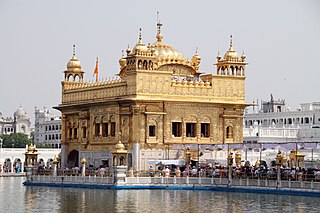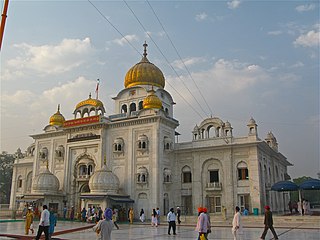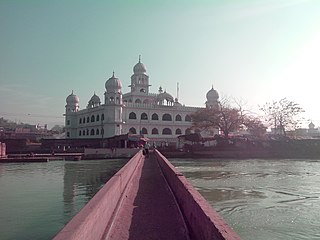| |||||
| Centuries: | |||||
|---|---|---|---|---|---|
| Decades: | |||||
| See also: | List of years in India Timeline of Indian history | ||||
Events in the year 1661 in India.
| |||||
| Centuries: | |||||
|---|---|---|---|---|---|
| Decades: | |||||
| See also: | List of years in India Timeline of Indian history | ||||
Events in the year 1661 in India.
| | This section is empty. You can help by adding to it. (August 2013) |

Sikhism, also known as Sikhi, is an Indian religion and philosophy that originated in the Punjab region of the Indian subcontinent around the end of the 15th century CE. It is one of the most recently founded major religious groups and among the largest in the world with about 25–30 million adherents.

The Guru Granth Sahib is the central holy religious scripture of Sikhism, regarded by Sikhs as the final, sovereign and eternal Guru following the lineage of the ten human gurus of the religion. The Adi Granth, its first rendition, was compiled by the fifth guru, Guru Arjan (1564–1606). Its compilation was completed on 29 August 1604 and first installed inside the Golden Temple in Amritsar on 1 September 1604. Baba Buddha was appointed the first Granthi of the Golden Temple. Shortly afterwards Guru Hargobind added Ramkali Ki Vaar. Later, Guru Gobind Singh, the tenth Sikh guru, added hymns of Guru Tegh Bahadur to the Adi Granth and affirmed the text as his successor. This second rendition became known as the Guru Granth Sahib and is also sometimes referred to as the Adi Granth.

Guru Har Rai revered as the seventh Nanak, was the seventh of ten Gurus of the Sikh religion. He became the Sikh leader at age 14, on 3 March 1644, after the death of his grandfather and the sixth Sikh leader Guru Hargobind. He guided the Sikhs for about seventeen years, till his death at age 31.

Guru Hargobind was the sixth of ten Gurus of the Sikh religion. He had become Guru at the young age of eleven, after the execution of his father, Guru Arjan, by the Mughal emperor Jahangir.

Guru Har Krishan also known as Bal Guru, or Hari Krishan Sahib, was the eighth of the ten Sikh Gurus. At the age of five, he succeeded his father, Guru Har Rai, and became the youngest Guru in Sikhism. He contracted smallpox in 1664 and died before reaching his eighth birthday. It is said that he died because he contracted smallpox while successfully curing his followers.

Guru Tegh Bahadur was the ninth of ten gurus who founded the Sikh religion and was the leader of Sikhs from 1665 until his beheading in 1675. He was born in Amritsar, Punjab, India in 1621 and was the youngest son of Guru Hargobind, the sixth Sikh guru. Considered a principled and fearless warrior, he was a learned spiritual scholar and a poet whose 115 hymns are included in the Guru Granth Sahib, which is the main text of Sikhism.
The following outline is provides an overview of Sikhism, or Sikhi.

Gurdwara Bangla Sahib is one of the most prominent Sikh gurdwaras, or Sikh house of worship, in Delhi, India, and known for its association with the eighth Sikh Guru, Guru Har Krishan, as well as the holy pond inside its complex, known as the "Sarovar." It was rebuilt as a small shrine by Sikh General Sardar Baghel Singh in 1783. In the same year, there was reconstruction of nine Sikh shrines in Delhi. There were attempts of occupancy by Raja Jai Singh of Amer, during the reign of Mughal Emperor, Shah Alam II.
Dal Khalsa was the name of the combined military forces of 11 Sikh misls that operated in the 18th century (1748–1799) in the Punjab region. It was established by Nawab Kapur Singh in late 1740s.

Bhai Mani Singh was an 18th-century Sikh scholar and martyr. He was a childhood companion of Guru Gobind Singh and took the vows of Sikhism when the Guru inaugurated the Khalsa in March 1699. Soon after that, the Guru sent him to Amritsar to take charge of Harmandir Sahib, which had been without a custodian since 1696. He took control and steered the course of Sikh destiny at a critical stage in Sikh history. He was also a teacher of the Gianian Bunga, later becoming known as the "Amritsari Taksal", currently located in Sato Ki Gali.
Mata Nihal Kaur, popularly known as Mata Natti, also known as Ananti, Nihalo, and Bassi, was the wife of Baba Gurditta.

Hola Mohalla, also called Hola, is a three-day long Sikh festival which normally falls in March. It takes place on the second day of the lunar month of Chett, usually a day after the Hindu spring festival Holi, but sometimes coincides with it. Hola Mohalla is a big festive event for Sikhs around the world.
Guru Nanak founded the Sikh religion in the Punjab region of the northern part of the Indian subcontinent in the 15th century and opposed many traditional practices like fasting, Upanayana, idolatry, caste system, ascetism, azan, economic materialism, and gender discrimination.
Vaisakh is the second month in the Nanakshahi calendar and the Punjabi calendar.

Guru Har Sahai is a city and a municipal council in Ferozepur district in the Indian state of Punjab. Nearby cities are Ferozepur, Sri Muktsar Sahib, Fazilka, Bathinda.
Sodhi is a clan of Khatris and Jatts originated from the Indian Punjab.

Ramraiyas, also referred to as Ram Raiyas, are a Sikh sect that follow Ram Rai, the excommunicated eldest son of Guru Har Rai (1630–61).

Kiratpur, also known as Kiratpur Sahib, is a town, just 30 km from Rupnagar city in Rupnagar district of Punjab, India. The town is the location of the Gurdwara Patal Puri where many Sikhs take ashes of their deceased.

Guru Ram Rai Darbar Sahib is a Sikh place of worship in Dehradun, India, dedicated to Baba Ram Rai, eldest son of Guru Har Rai, the seventh of the ten Sikh Gurus. Baba Ram Rai settled here with his followers in the mid-17th century, after he was banished by the Sikh orthodoxy for mistranslating scripture in front of the Mughal emperor Aurangzeb, so as to not cause offence. It is believed the city, Dehradun, gets its name from the religious camp established by him: a "dera", or camp, in the "doon" valley.

Ram Rai was the excommunicated eldest son of the seventh Sikh Guru, Guru Har Rai, and the founder of the Ramraiyas, an unorthodox and heretical sect in Sikhism.